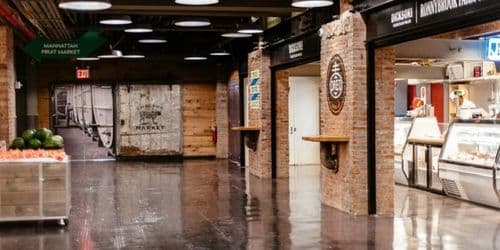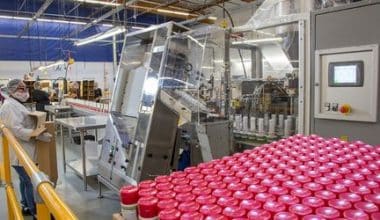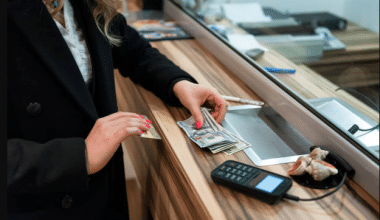At shopping malls, town centers, city streets, or the outskirts of small settlements, brick-and-mortar stores can be found. It sells things for customers to visit, view, and purchase, such as apparel or food.
Despite the increased emphasis on online purchasing brought on by the COVID-19 epidemic, brick-and-mortar retail stores continue to expand. In 2023, US retailers will open twice as many stores as they will close. If you’re interested in brick-and-mortar retail, you’ve come to the perfect spot. This guide explains the brick-and-mortar store concept, provides examples of successful retailers who own their own stores, and explains how to open a brick-and-mortar store business of your own.
What Is a Brick-and-Mortar Store?
A brick-and-mortar business is one that has at least one physical location where clients can visit. (as opposed to solely online) A brick-and-mortar store is a name given to the storefront.
Traditionally, brick-and-mortar retail stores were THE way to do business. Consumers come to the store, select the things they desire, and a store clerk assists and completes the transaction.
The 5 Essential Components of a Brick and Mortar Store:
- Visible and physically accessible inventory
- Promotional displays that stand alone and are occasionally interactive
- Staff that are willing to assist customers during their purchasing experience
- Signs and a physical layout to keep people interested and moving forward
- An ambiance that reflects the store’s brand
Brick-and-mortar stores today frequently do more than just sell things. Customers want distinctive, branded experiences from retail stores. More on this later. We’ll teach you all you need to know to run a profitable brick-and-mortar store now and in the future.
Types of Brick-and-Mortar Stores
Not all brick-and-mortar stores are the same. The most successful stores adhere to their “retail formula” to the letter. It explains exactly how the store operates. Yet, the beginning point is the type of brick-and-mortar store.
Some are smaller and offer a limited selection of products. Other, larger stores sell things from a variety of categories. Some sell high-end stuff, while others sell lower-cost items.
Here, we’ll take a quick look at the most prevalent types of brick-and-mortar retail stores, describing the major characteristics of each as we go.
#1. Departments Stores
Department stores are divided into sections, each of which sells things based on a certain need or subject.
Typical departments within these retail stores include:
- Clothes and Accessories
- Jewelry Appliances
- Electronics
- home decor
- …the list goes on
This variety allows department stores to generate a lot of business from clients who come in with a range of wants.
#2. Specialty Stores
Specialty stores sell products that are tied to a single theme or consumer need.
A few examples:
- Hat stores
- Sporting goods depot.
- Jewelry stores
- Mattress stores
Because specialty stores are so narrowly focused, they can cater to a more targeted demographic and provide more laser-focused value.
#3. Convenience Stores
Convenience stores are tiny, neighborhood shops that sell “everyday” products, basic necessities, and impulse items such as:
- Gas
- Milk and eggs
- Cigarettes and alcohol
They are the ideal pit stop for clients on the go, which almost guarantees foot traffic throughout the day and night for store owners.
#4. Supermarkets and Food Stores
Grocery stores and supermarkets primarily sell food and food-related items, but they also frequently provide domestic essentials and consumables.
One of the most significant advantages of owning a grocery store is the potential to generate consistently, repeat business from loyal consumers. When you provide things that customers require on a regular basis, they will always have a need for your brand.
#5. Drugstores
Drug stores have more options than convenience stores but fewer than grocery stores and department stores.
Drug stores usually sell health and beauty products, while not strictly being “specialty stores.”
Because of the increased emphasis on vital health-related equipment, local drug stores have become a go-to destination for those in need of treatment.
#6. Superstores
Superstores are essentially a hybrid of all of the previous categories of brick-and-mortar stores.
They have the capacity to create a business from customers from different walks of life, with varying needs. As you might expect, building a big store is probably not in the cards for the inexperienced entrepreneur.
#7. Discount Stores
Discount stores are low- to no-frills businesses that offer high-quality products at low rates. They can be found in a variety of niches, most commonly in supermarkets, department, or specialty stores.
Discount stores often generate a small profit from individual sales, but their low cost allows them to stretch revenues considerably further than more expensive “big box” stores.
Each form of brick-and-mortar store has advantages and disadvantages.
The key to success for retailers is to understand how to maximize their store’s capabilities in order to deliver maximum value to their customers.
Steps To Open Your First Brick and Mortar Stores
- Choose the appropriate location
- Choose a POS (point-of-sale) system.
- Recruit and train retail employees
- Manage inventory
- Try out pop-up stores.
- Make the store COVID-safe.
- Combine in-store and online shopping
Let’s go over seven steps you can take to open your own brick-and-mortar store.
#1. Choose the appropriate location
It’s tempting to make an offer to rent a storefront in a bustling commercial zone. More people mean more retail purchases, right? Not always.
While selecting the right space for your store, there are several aspects to consider, including but not limited to:
- Where are your customers?
- Traffic
- Competitors
- Accessibility
#2. Choose a POS (point-of-sale) system
The next stage in building a brick-and-mortar store is to select a POS system. This is the machine that will allow you to accept payments from customers in the store. Systems like Shopify POS accept most payment methods, including mobile apps and credit cards.
The best part? If you’re opening a store to coexist with your online store, Shopify POS works effortlessly. The in-store technology keeps you up to current on stock levels, assisting you in managing inventory across several sales channels. You will also be able to provide click-and-mortar services (like buying online and picking up in-store).
#3. Recruit and train store employees
Retail employees are the face of your store and are typically the first retail position you’ll hire. Associates are the initial point of contact for any in-store shoppers who require assistance, and they help boost sales and manage foot traffic to your brick-and-mortar store.
When you hire your first retail worker, their daily responsibilities may include:
- Welcoming customers and supporting them with their purchases
- Using your POS system to process payments
- Managing in-store refunds and exchanges
- Making visual merchandising displays to attract passers-by
- Encouraging brand loyalty programs
#4. Inventory control
Inventory management is the practice of keeping track of which things are for sale.
According to research, retail inventory is only accurate 63% of the time. If retailers do not manage inventory offered through several channels, they frequently find themselves selling out-of-stock items.
Controlling inventory is notoriously challenging. It’s a balancing act between having too little stock (and hence nothing to sell) and having too much stock (that either spoils, goes out of style, or takes up too much space in your store).
Combine your online stock with your in-store inventory to keep track of it. Shopify, for example, displays inventory levels for each item as soon as it is sold online or in-store.
#5. Try out pop-up stores
Pop-up stores are an excellent method to experiment with brick-and-mortar. Other retailers with their own storefronts lend it to newer businesses rather than committing to a year-long lease.
Last year, DTC company Gymshark experimented with its own pop-up store in London.
Gymshark provided free fitness sessions to anyone who visited the venue in an effort to enhance product sales and provide wonderful experiences. They duplicated the pop-up in cities around the world, including Toronto, where 90% of the inventory was sold on the first day.
Birchbox also opened its first pop-up shop to test out brick-and-mortar. It held pop-ups in numerous locations across the United States and established a permanent shop in its most popular location: New York.
#6. Establish the store COVID-safe
It goes without saying that COVID revolutionized the way people shop. Among those who feel confident going in-store, the great majority feel safer when businesses take efforts to decrease the risk of infection.
Among them are:
- Hand sanitizer upon entering
- One-way systems for entering and leaving the store
- Numbers are limited, and shopping periods are scheduled.
- Self-service checkout and contactless payment
- Click-and-collect services (like curbside pickup)
- Virtual fitting rooms allow you to try on clothes without having to touch them.
#7. Combine in-store and online purchasing
We’ve briefly discussed how you can use your physical presence to boost online sales. Omnichannel retail, which merges the two shopping channels, is becoming the rule rather than the exception. 73% of customers shop across various channels.
The simplest method is to acquire your clients’ email addresses when they shop in-store. This information can be used for future retargeting, either to drive customers back to their local store or to make an online purchase.
Consider encouraging in-store customers to share their purchases with their friends as well. Friends and family recommendations are the most trustworthy sources of promotion. Get customers talking about your store by rewarding them for it.
E-commerce vs. Brick-and-Mortar Store
Brick-and-mortar and online retail are two very distinct beasts. The most obvious distinction is that brick-and-mortar stores exist in the physical world, whereas eCommerce stores have their webshop online.
eCommerce platforms such as Magento, Shopify, BigCommerce, and others are frequently used to power online stores.
The various site types result in a completely different experience for the customer — and a different method of doing business for the organization.
It’s worth examining down each’s primary assets and the biggest problems you’ll face if you go either way.
The Benefits of a Brick and Mortar Store
There are several possible benefits to running a brick-and-mortar store, most of which are related to consumer interaction. The following are some reasons why some business models may be better suited to physical stores.
#1. Foot traffic:
The most obvious benefit of having a physical location is the spontaneous foot traffic that might draw new clients to your business. Increased consumer traffic leads to more sales, especially for new or small stores that may not have the budget for promotion.
#2. Staff:
One of the most valuable aspects of the in-store experience is attentive and helpful personnel. When a customer enters a physical store, a staff member can answer their queries, make recommendations, and even explain more about the products, which is largely unavailable to online businesses.
#3. Immediate gratification for customers:
Having a physical presence allows buyers to try on their products to see how they fit, feel, and look. Consumers do not have to wait for their product to be transported, as they would with online transactions, providing them with instant satisfaction and convenience that they may return to later.
#4. Several payment options:
Internet stores only accept debit and credit cards. A POS system that accepts cash, checks, and credit and debit cards are often used by an offline local business. This attracts a larger range of customers, potentially increasing total retail sales for a store.
Disadvantages of a Brick and Mortar Store
The most significant disadvantage of owning a brick-and-mortar business is the lack of flexibility and overhead expenditures associated with running a physical store. This is a list of some of the potential downsides of owning a brick-and-mortar business.
- Rent: The cost of leasing a commercial location is sometimes the most expensive expense for a brick-and-mortar business. Renting commercial real estate is far more expensive than running and managing a website. Commercial leases can also be rigorous, binding, and extend for years, even if the business needs to close or relocate. Throw in the costs of utilities for operating the facility, and a business’s overhead expenditures skyrocket.
- Staff costs: Even if your business does not require salesmen, brick-and-mortar locations will require a staff to execute basic store maintenance. Employees may require benefits such as healthcare, tuition reimbursement, or pension plans in addition to hourly rates or salary, all of which will reduce your bottom line.
- Restricted reach: While foot traffic is certainly beneficial, it can only bring in so much business to a store. Even if a firm has the resources to carefully put its brick-and-mortar stores in high-traffic, high-income locations, a business will be constrained by its geographical location. Businesses that want to reach a worldwide audience may profit from operating entirely as internet firms.
- Showrooming: Showrooming occurs when a customer visits a real retail store to try on products before purchasing the same or a similar item online. This phenomenon can help merchants with an internet presence, but it can hurt brick-and-mortar retailers.
What is the Return Rate For Brick-and-Mortar Stores
Brick-and-mortar stores had an average return rate of 8.9%, compared to about 30% for internet stores. This could be because it is more difficult to evaluate internet goods before acquiring them.
How Many Brick and Mortar Stores Exist In the United States?
In the United States, there are slightly more than a million retail enterprises. The precise figure as of 2020 was 1,045,422.
Alternatives to a Brick and Mortar Stores
If a standard retail store does not meet your goals or budget, you have other possibilities for starting your business. Some of the most popular alternatives to brick-and-mortar stores include:
#1. E-commerce stores
E-commerce sites are simple to operate, relatively inexpensive, and a popular option for buyers who value the ease of online buying. Compared to brick-and-mortar stores, e-commerce stores have lower overhead costs.
They also allow you to start selling your things without having to put up a physical storefront. Yet, some buyers are concerned about the validity of a new online store, so it may take longer to create confidence and a client base. You must also include shipping and website charges.
#2. Food trucks
Consider a food truck business if you want to run a restaurant but don’t want the expenses that come with it. This method is far less expensive and allows you to travel to high-traffic places and events to reach new audiences. A food truck can be a wonderful place to start, allowing you to eventually open a permanent restaurant site. When you’re cooking rapidly in a tiny space, your food options are limited.
#3. Kiosks
Kiosks are a terrific method to establish a physical presence in a high-traffic place without the upkeep and expenses of a brick-and-mortar store. They are cubicles or open-fronted constructions that allow you to display your products or services and entice clients to learn more about them. Malls are great places to rent a kiosk; you’ll commonly see them throughout the mall corridors.
Depending on your sales trends and preferences, you can run a kiosk seasonally or year-round. For example, you’ll often find temporary kiosk companies throughout the holidays selling gifts, decorations, seasonal food, or calendars.
#4. Farmers’ markets
Many cities conduct regular farmers’ markets where local business promote their products and services on a weekly or monthly basis. At a farmers market, you rent a small area and put up a booth where you may display your most popular goods or services and engage directly with possible clients.
This option is ideal for small businesses seeking increased exposure and cost-effective methods of increasing sales. The farmers market may restrict the types of things you can sell, so check the rules of your local market before going this route. Farmers’ markets in cooler climates may also be limited to the summer months.
#5. Pop-up stores
A pop-up shop is a temporary operation that allows businesses to operate in a brick-and-mortar store. Pop-up shops enable business owners to rent out commercial or retail real estate for a limited time and outfit and operate the location as a brick-and-mortar store. This provides an opportunity to boost the visibility of your business without requiring the long-term commitments of traditional brick-and-mortar venues.
#6. Mobile retail units
Mobile retail units are essentially food trucks for other types of businesses, such as clothing or jewelry stores. This option is ideal for businesses that wish to migrate to different places to raise brand awareness without incurring the overhead costs of a pop-up shop or brick-and-mortar site. You can utilize social media to publicize where your mobile retail unit will be next to keep clients up to speed on your whereabouts.
Software for Point-of-Sale (POS) in Brick and Mortar Stores
Point-of-Sale (POS) software is a critical component of a brick-and-mortar team’s technology stack. The POS system in a store serves as its digital hub, simplifying the following processes.
- Consumer transactions: Employees complete purchases, refunds, and exchanges immediately through the store’s POS system.
- Sales Reporting and Analytics: POS tools collect transactional data for sales reporting and analytics. It provides information about the store’s business performance.
- Inventory management: As inventory is moved from storage to display shelves and finally to the customer, the information is recorded in the POS.
- Employee scheduling and management: POS systems measure employee hours as well as performance on the job.
- Registration of customer profiles and tracking loyalty marketing (points, etc.) for customer retention and email marketing follow-ups.
Payment choices are frequently supported by point-of-sale systems. Mobile payments (such as Square and PayPal), credit cards, and other traditional payment methods are accepted by modern POS systems.
POS software is aided by in-store hardware, including
- Barcode scanners to speed up transactions.
- Credit card scanners are used to secure credit transactions.
- Printers are used to record transactions and generate receipts.
- Static POS systems can also serve as cash drawers.
While there are many POS tools available, three of the most popular “new kids on the block” are:
- Shopify POS offers a streamlined, customer-focused checkout experience as well as omnichannel store management capabilities.
- Vend POS, which supports a variety of add-ons and connections and enables a completely configurable checkout experience.
- Square POS (one of Square’s eCommerce technologies), allows brick-and-mortar stores to sell omnichannel.
What Is Brick and Mortar Banking?
When compared to visiting a branch in person, brick-and-mortar banking refers to the practice of depositing and borrowing money using online banking programs or websites. Many retail banks are closing offices in order to provide more services by mail, phone, or the internet.
Conclusion
In contrast to internet stores without a customer-facing storefront, brick-and-mortar refers to retail stores and offices that customers may visit in person. While offering a more personalized shopping experience, these stores are being undercut by internet stores with significantly cheaper overhead expenses. Yet, some services, such as hair salons and grocery stores, are still mostly conducted in person.
Related Articles
- WHAT IS A POP-UP SHOP? Best Pop-Up Ideas In 2023
- Spalling: A Comprehensive Guide [+ Quick Tips]
- BLACK FRIDAY STORE HOURS IN 2023: How Long Will It Last
- The 19+ Best POINT OF SALE SYSTEMS FOR SMALL BUSINESS in 2023 (Updated)
- RETAIL BUSINESS: Definition, Types & How to Start It
- OVERHEAD: What Is It, Overhead Cost & How to Calculate It






